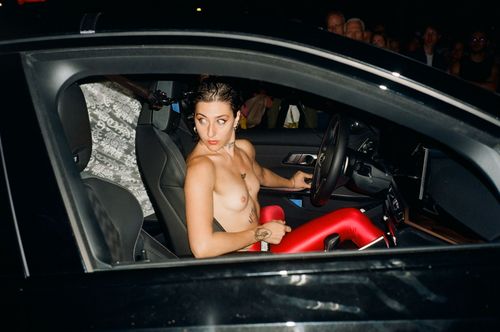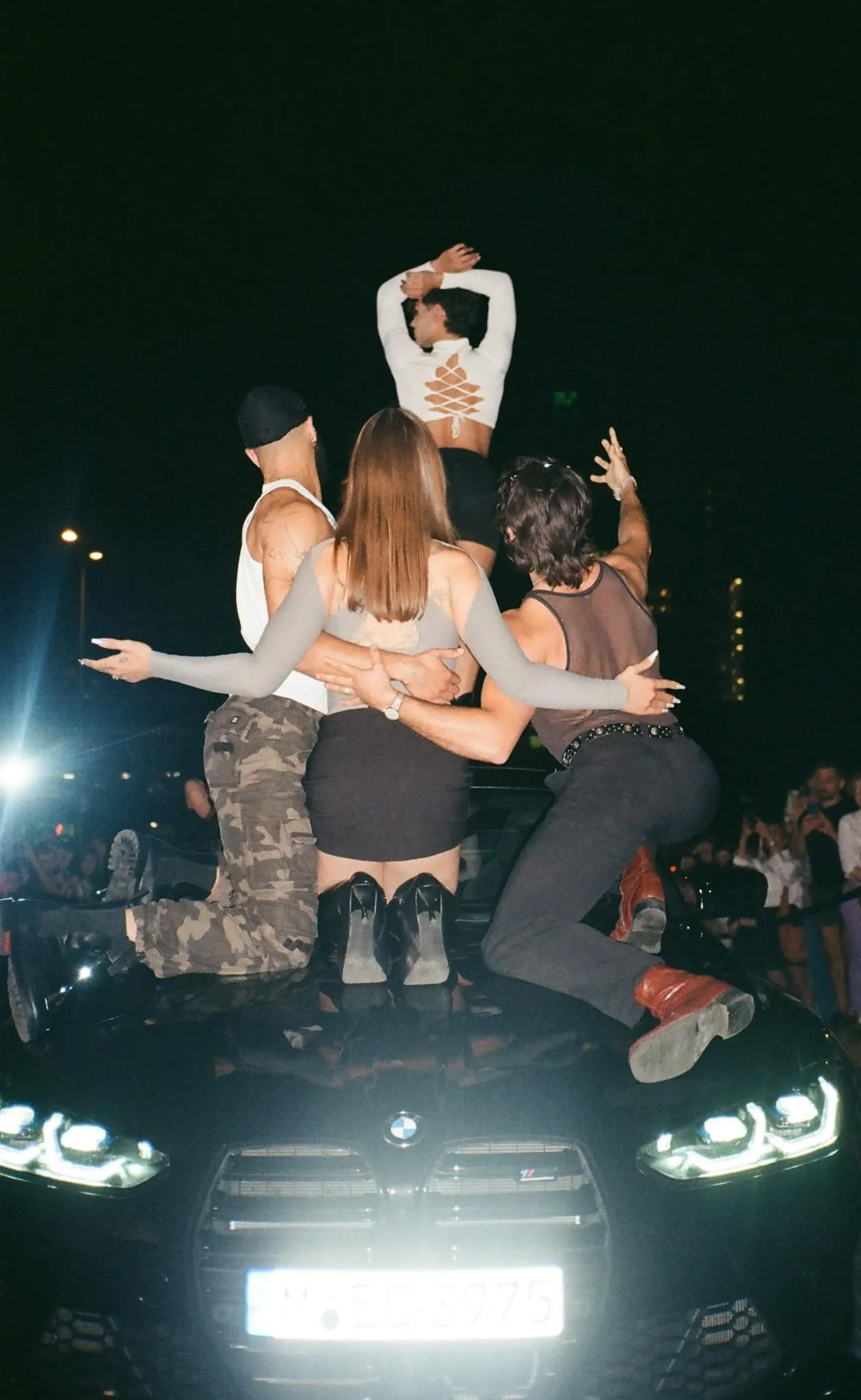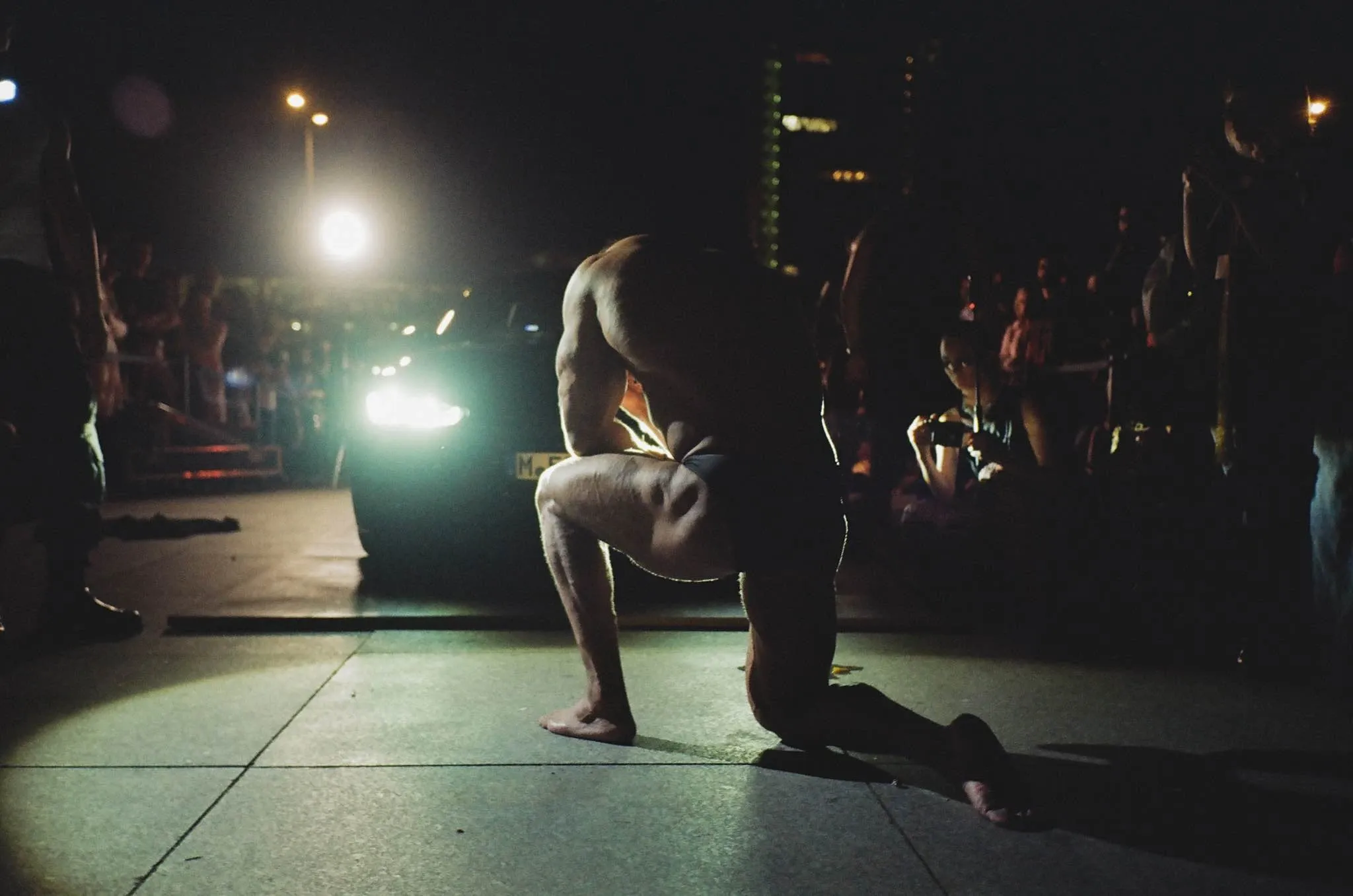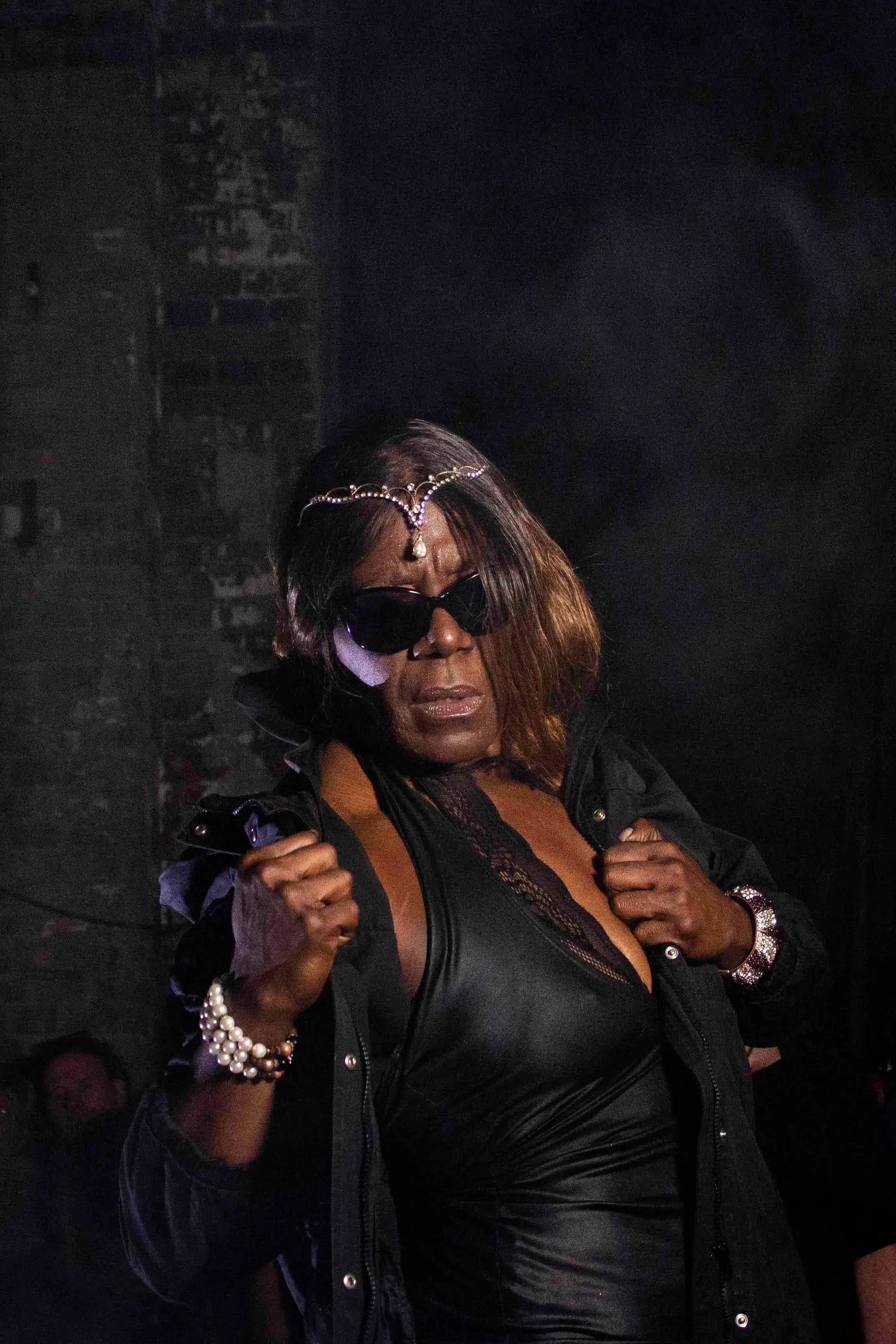INDEX
Camouflage as Resistance: On Göksu Kunak

Göksu Kunak gained acclaim at the most recent Performa Biennial 2023 in NYC or as editorial correspondent to Ibraaz, transitioning from a role as a writer and art critic to becoming an artist known for their work in performance and installations. Kunak explores notions of self-censorship and Eastern-futurism in their productions, setting them apart. Yet, Kunak defies the lone genius trope, instead valuing community engagement and the belief that influential artists are those deeply intertwined with and contributing to their communities. This philosophy advocates for a shift from individual shock tactics in the arts to societal engagement and critique, emphasizing the socio-political underpinnings of creativity.
From captivating onlookers atop a car on the Neue Nationalgalerie's terrace in "VENUS" to seizing the spotlight on a construction scaffold in 'HUNGRY' Kunak's performances and installations leave an indelible mark. Seamlessly weaving elements from pop culture with the elements from the underground, they juxtapose sleek, hyper-sexualized figures against the backdrop of pulsating techno and hardcore beats. Though the persistent use of red and white in their art may recall Barbara Kruger's photomontages, it reflects the hues of the Turkish flag, a nod to their birthplace and upbringing before relocating to Berlin nearly a dozen years ago.
Their creative expression blends modern perspectives from authors such as Paul B. Preciado, who, alongside Viktor Neumann, selected them for The Parliament of Bodies during the Bergen Assembly back in 2019, with the enduring stories of ancient Eastern mythology. This fusion is dramatized in high-energy, long-duration performances that starkly contrast with their exploration of vulnerability and invisibility, positioning these elements as powerful tools for existence/resistance.
Last week, on a bus journey from Essaouira to Marrakech, I seized the opportunity to interview Kunak. Our conversation delved into the concepts of self-Orientalisation and the art of camouflage.

@'VENUS' at Neue Nationalgalerie with Felix Beer, Bugra Büyüksimsek, Chima Nnamdi Okerenkwo, Markus Hausmann, Nomi Sladko Producer Florian Greß photos by Jiri Abendt
E.R.: Your performances often juxtapose pop culture elements, such as references to Turkish TV shows with their hyper-gendered body portrayals, alongside family portraits. You also repurpose objects like cars, treadmills, concrete blocks, and gasoline tanks, turning them into stages or props. This method creates a hyper-collage, where each element becomes meaningful as part of the whole. Could you elaborate on this technique?
G.K.: Absolutely. One foundational concept in my work revolves around the interplay between objects and what I refer to as 'non-objects,’ reinterpreting their meanings, forming the core of my methodology.
Storytelling is essential, where I move beyond binary evaluations of objects to explore their potential through fluid engagement. These objects, integrated into installation, become key components of the narratives I seek to convey. Central to my approach is the creation of 'hyper-assemblages' where repurposed objects, each with its own history, come together to form new, dynamic stories. This process transcends traditional collage, evolving into three-dimensional installations that engage viewers spatially and narratively, akin to interconnected stories. My work imbues objects with new meanings, creating layered narratives within spatially engaging installations. This practice challenges linear storytelling, embracing complexity and interconnection. Through 'hyper-assemblages,' I aim to dismantle existing narratives and forge new ones, highlighting the depth and multiplicity of stories beneath the surface. This approach not only redefines objects within my installations but also invites viewers to explore the narratives and experiences these objects embody, promoting a deeper, more nuanced understanding of their significance.
E.R.: In your insightful 2016 essay 'Queer Chronopolitics: Forests, Freaks, and Performativity'; you delve into the character of Humbaba from the ancient Mesopotamian “Epic of Gilgamesh”. Humbaba, a forest deity, embodies what you describe as the archetype of 'the freak'—a queer figure residing in a sacred forest that King Gilgamesh seeks to obliterate in his quest to establish a 'civilized' world. Within this epic narrative, I also got to learn about the character of Shamhat —a temple prostitute, or harimtu, tasked with transforming Gilgamesh's companion, Enkidu, from his wild state into a 'civilized' human through the act of sacred love-making. This transformation, however, leads Enkidu to curse Shamhat at the moment of his mortality, blaming her for his exposure to a world that ultimately brings about his demise. Yet, upon being reminded by the gods of Shamhat's nurturing role—feeding and clothing him—Enkidu transitions from cursing to blessing her.
Your work is distinguished by its inclusive collaborations with pole dancers, body-builders, and individuals residing on society's margins, yet playing pivotal roles within it. This approach intimates that their participation is crucial to a more expansive collective understanding. Could you discuss how this facet of your practice intersects with the ideas presented in your essay, especially concerning Humbaba and Shamhat? How do you see the interplay of 'freak' identities and the transformative role of sexuality challenging or reinforcing societal norms?
G.K.: Back then, I adopted a politically charged, black-and-white stance, which has since evolved into embracing the complexities and nuances of various issues. I am really into gray zones at the moment. This shift reflects in my exploration of characters like Shamhat from the 'Epic of Gilgamesh' and similar figures in other mythologies, such as a character I recalled related to Buddha's story, known as ‘Siddartha'
Presently, my work increasingly focuses on celebrating this phenomenon, acknowledging the existence and importance of characters who have been marginalized. For instance, I have moved away from labeling myself solely as a 'queer artist from Turkey' in my biography, recognizing that such identifiers, while important for identity politics, can also contribute to self-marginalization or pigeonholing.
My current approach emphasizes the collective existence of all beings and objects without focusing solely on their marginal stories. This perspective treats everyone—regardless of their background or role in society—as integral parts of a broader, inclusive narrative. Whether it is a bodybuilder, a sex worker, or any individual, I aim to highlight their strengths and contributions beyond the conventional narratives that have traditionally defined them.
This methodology draws from the foundational ideas in my essay, which remains dear to me, but I've adapted it to foster a more inclusive, non-marginalizing approach. By incorporating diverse characters and their unique stories into my work, I strive for a form of storytelling that embraces all forms of identity and experience, challenging traditional Western methodologies. Ultimately, my goal is to reimagine society through storytelling, utilizing science fiction and speculative fiction as tools to envision a world where every character's contribution is valued, without dismissing anyone's existence.
E.R.: You foresee my next question…Your latest performance, 'Acâibü’l-mahlûkāt' inspired by the eponymous 13th-century Persian cosmology book on that you presented at Sophiensaele Berlin and the latest Performa Biennial, explores the depths of Eastern cosmology. With forwards from the current Turkish President, the juxtaposition of politics with mythology emerges as stark, odd. How important is world-building to your artistic process?
G.K.: I'm deeply drawn to mythologies, especially the Epic of Gilgamesh and the archetypes it presents, particularly 'the Other.' This fascination isn't just about retelling old stories; it's about exploring how these ancient concepts of 'the Other' find relevance in our modern world. For instance, the Epic of Gilgamesh has been a significant influence, guiding me to consistently incorporate 'the Other' in my creations. Another piece that captivates me is based on a 13th-century text that was translated into Ottoman. This text introduces mythical beings that, while considered outlandish today, were normalized in the past. The book suggests that these beings' existence is conceivable because of the limitless creative capacity of the divine. In 2019, the President of Turkey even wrote a foreword to an edition of the book. It was ironic to me since, the opposition of any form is silenced in Turkey, and the book contains characters that definitely don't reflect the society that is wanted in the country right now.
My artistic exploration revolves around these 'othered' mythological characters, imagining their place in today's world. It's not about nostalgia but creating a collage that weaves together the past, present, and future, showcasing how these ancient 'Others'; could be walking among us today, not as grand mythological figures but as everyday individuals with their unique stories. This approach extends to my interest in storytelling and trans-temporalities, using these myths as a foundation to discuss the concept of 'the Other' without further othering. My work is heavily influenced by speculative and science fiction, with authors like Samuel Delaney providing rich material on coexistence and diversity. My aim is not to idealize or directly portray queer characters but to engage with speculative fiction as a means to discuss existence and identity beyond mere visibility.
To that effect, camouflage plays a crucial role in this narrative, reflecting on how individuals navigate public spaces, especially in contexts like Turkey, where expressing queer identity openly can be challenging. I've had conversations with friends who've moved from such restrictive environments to more accepting ones, and these discussions shed light on the subtle acts of defiance and self-expression through the way one walks or presents themselves. Ultimately, my work seeks to explore the subtleties of identity and existence, drawing from mythology to speak on contemporary issues of visibility, identity, and the fluidity of self-expression in a society that often demands conformity.
The idea of coming out, as celebrated as it is, strikes me as a distinctly Western concept. There's this other side to it, a sort of camouflage, where you navigate life under the radar, doing what you want without the need for grand declarations. I'm not suggesting one approach is superior to the other; they both have their advantages and drawbacks. But consider for a moment the societal constraints some people live under. Not everyone is cut out to be an activist, not everyone wants to be. Some might be introverted or insecure, simply wishing to live their life on their own terms. For them, camouflage isn't about hiding; it's a form of self-preservation, a way to move through the world more freely, perhaps with a bit of flair in their step, their 'diva walk', without drawing unwanted attention. There's this fascinating dynamic where, in some places, having a partner who could pass as a cousin allows for a certain freedom, a playful subversion of norms. I think it's crucial to acknowledge and value these forms of invisibility. Visibility is important, yes, but there's a point where the push for it can overshadow the significance of choosing to remain unseen. This choice, this 'invisibility', is a powerful tool for some, allowing them to exist in spaces that might not be as accepting otherwise. It's about the subtle art of disappearance, of being present without being overt, which I find incredibly intriguing.

@'VENUS' at Neue Nationalgalerie with Felix Beer, Bugra Büyüksimsek, Chima Nnamdi Okerenkwo, Markus Hausmann, Nomi Sladko Producer Florian Greß photos by Jiri Abendt
E.R.: In 'Cabaret Portrait: Döner Blackout II,'; you touch upon Sara Ahmed's concept of self- orientalizing, noting that "Orientalism necessitates distance. So, what type of distance must onecreate from their own culture to engage in self-Orientalization?" Could you expand on this idea?
G.K.: During my time in Turkey, as an art historian, my work was very much influenced by orientalism. This was also a significant part of my education, especially around 2009 and 2010 when the concepts of decolonization, imperialism, and orientalism were pivotal to understanding art history. Interestingly, these concepts came to Europe later. Whereas, in Ankara my professor Zeynep Yasa Yaman was critically examining the influence of orientalism in art, acknowledging its importance but also grappling with its problematic aspects, such as the use of African masks and the portrayal of Middle Eastern women's bodies by renowned male artists.
Moving to Germany and living here for the past 12 years has shifted my perspective towards self-orientalization. Initially, I noticed tendencies of self-orientalizing in my own behavior and presentation. This reflection broadened as I observed how countries from the Global South, including Turkey, market themselves to Europe through advertisements or the portrayal of celebrities and cultural products, embodying a form of self-orientalism. It';s not about labeling it as good or bad but recognizing it as a fascinating methodology and understanding how we, from the East, might view ourselves through the lens of the more powerful West.
John Berger’s insights in 'Ways of Seeing' about the male gaze and how women perceive themselves through this gaze resonate with my thoughts on self-orientalization. Berger said “Men look at women. Women watch themselves being looked at.” It illustrates how women internalize the male gaze, continuously observing themselves from an external viewpoint, which parallels how Eastern identities might recalibrate their self-perception in the context of Western perspectives. Similarly, the West look at the east and the east look at themselves being looked at.
This dynamic of seeing and being seen, of power in the gaze, extends beyond the East-West dichotomy. It's prevalent in queer communities and various social interactions, transcending gender to underscore broader power dynamics. The act of looking and the power it entails reflect deeply ingrained societal structures. Recognizing and challenging these dynamics in my work and personal reflections has been a crucial part of my journey, aiming to rebalance the gaze and understand how it shapes our self-identity and interactions with the world.
E.R.: Murid Barghouti, a celebrated Palestinian poet wrote 'I have learned that there is a state of absence which makes you see nothing but absence; absence of everything that is absent in you and in your life.' In his collection of poems entitled 'I Saw Ramallah' this poignant exploration of absence invites readers to reflect on the profound effects of displacement and loss. Your work similarly delves into themes such as time, absence, un(veiling), in(visibility), and decay. Could you discuss how these themes resonate in your work?
G.K.: Context is crucial when we talk about visibility and invisibility, especially considering the situations in places like Palestine and the Kurdish regions in Turkey. These scenarios underscore the necessity of visibility to highlight certain issues and injustices. My earlier comments on the choice to disappear or remain invisible were about personal decisions, the agency over one's visibility. However, it is also critical to acknowledge that in certain historical and political contexts, making stories known and visible is vital.
Take, for instance, the discussions around the headscarf or the burqa from a Western feminist perspective, where it is often viewed through a lens of pity or oppression. Yet, what if the choice to wear a headscarf or burqa is a deliberate one, a form of agency rather than oppression? I'm acutely aware of the problematic aspects of male dominance in these contexts, having experienced them myself. But it's also essential to recognize that for some women, these choices are about asserting their identity in a way that aligns with their values and desires, not about disappearing but choosing a different form of presence.
My reflections on absence and presence are tied to this idea of agency—deciding who wants to be visible and who prefers not to be, and how we respect those decisions. It's about understanding and honoring the agency of individuals in how they navigate the world. This isn't just theoretical; it's about real choices people make every day. For instance, I have friends of color who resist being pigeonholed as spokespeople for entire movements. They, like anyone else, might choose to step back from public discourse, focusing instead on their work or personal lives. It is these varied methodologies of engaging with the world that I believe we should respect and support, recognizing the diversity of ways people choose to be present or absent in their contexts.
E.R.: Recently, you collaborated with Andrea Bellini to co-edit a collection of essays titled 'Artists’ Survival Kit.' This work shines a light on the precarious economic realities faced by many artists, which often contrasts sharply with the glamorous image promoted by mainstream art institutions. The collection positions you alongside your peers, advocating for a shift in the art world by urging institutions to enhance their engagement with artists, particularly addressing issues of vulnerability and precarity. Could you elaborate on the motivations behind this project and your vision for how it might influence the relationship between artists and art institutions?
G.K.: My interest lies in exploring various hacking methods within the tech industry, particularly those aimed at boosting productivity. I've always been open to learning from a wide range of voices, regardless of their controversies, because I believe it's crucial to step outside my echo chamber to truly understand the diverse forces shaping our world. For example, listening to figures like Tim Ferris has not only introduced me to unique productivity strategies but has also provided me insights into the minds of highly influential people.
During a workshop at the CAMP-One Week of Living, Working and Performing curated by Andrea Bellini and July Weber, I applied this curiosity by asking them—talented artists facing precarious circumstances—about their work methodologies and how they tackle procrastination. One anecdote that stood out was from a friend, an exceptional performer, who mentioned in a book’s introduction that despite recently winning a significant award, they had only 20 euros in their bank account. This paradox of recognition without financial stability was a common theme among the artists we hosted, many of whom shared their experiences of working for minimal pay and even sleeping in the museum where our festival took place.
These conversations revealed the resilience and creativity required to navigate the art world's precariousness, which often remains hidden behind the veneer of success. It led me to ponder how we could 'hack' these narratives, akin to productivity hacks in the tech world, to offer alternative perspectives on success and struggle in the art scene. Inspired by tacky personal development books like ‘Surviving this’ or ‘Atomic Habits that, I'm intrigued by the idea of creating a resource that doesn't just instruct but serves as nutriment or food supplementation for artists. This project would involve collecting insights from prominent figures about their challenges and coping mechanisms, aiming to provide a more relatable, enriching resource for artists navigating their paths amidst uncertainty
E.R.: In the 19th century, the advent of the telegraph played a crucial role in synchronizing the extraction, transportation, manufacturing, and trading of natural resources from European colonies. This technology, emanating from metropolitan centers, enforced a particular understanding of time and nature onto diverse cultures and perspectives. Similarly, the introduction of rail transport brought with it machine-mediated punctuality and the industrial organization of daily life. Today, calendars and clocks are parameters that tell us when we are. In an age defined by hyper-connectivity and technological advancement, Big Tech continues to perpetuate a form of colonialism, now through digital means. Could you share your thoughts on how time and technology are interrelated? What are your aspirations for the future in this context?
G.K.: Two main thoughts come to mind when considering the intersection of imperialism, technology, and my work. Firstly, the role of trains as instruments of imperialism and colonialism is significant. I was revisiting Timothy Mitchell’s ‘Carbon Democracy’ while working on my piece PETROL,’ which delves into how train networks, like the Baghdad Express or Orient Express, were developed in Turkey primarily to access oil reserves and archaeological sites for Western powers. This echoes the historical agreements, such as Germany with the Ottoman Empire, facilitating the transfer of archaeological treasures to institutions like the Pergamon Museum in Berlin, in exchange for railway construction. It's a stark reminder of how these ‘agreements’ served imperial interests, facilitating access to strategic resources and sites.
Regarding technology and surveillance, the use of drones presents a contemporary parallel, highlighting ongoing power dynamics. In Germany, for instance, drone operation requires specific authorization, contrasting sharply with how drones are deployed by Western powers in the Middle East, often with little regard for sovereignty or privacy.
My fascination extends to the concept of time, particularly the notion of time traveling beyond its conventional, technological interpretations. Instead, I'm drawn to time traveling through storytelling. A recent studio visit from curator, theorist and scholar Kerstin Stakemeier, sparked an interesting comparison of my work to that of Russian Futurists—not the painters, but the literary figures. Their approach to time wasn't rooted in nostalgia or future-gazing but in taking elements from the past, cutting and reassembling them to create a new present, a future collage of sorts. This resonates with my perspective on time and the future, where even problematic elements of our era are not negated but repurposed.

@Hallen4 ©DevidGualandris
My method involves intuitively linking disparate elements—like telegrams, drones, and surveillance—to explore how these technologies intersect with our present and how they're perceived through the lenses of power dynamics, optics, and gaze. The historical and cultural depth of optics in Arab literature and its implications in Western art history inform my approach, offering a fresh lens on technology and visibility.
It's an ongoing inquiry, one where I'm still formulating answers, driven by an intuitive exploration of how we perceive and are perceived in a world shaped by technology.
E.R.: Do you consider yourself a provocateur?
G.K.: To be honest, my actions are often perceived as provocative, not because I aim to provoke, but simply because of who I am. Provocation, to me, feels a bit cliché. My intention is never to stir controversy; I merely act in a way that's true to myself, which, in the context of our world, can appear provocative.
I'm also mindful of cultural and situational contexts. For instance, in Turkey, I adapt my attire and behavior on the one hand out of respect for the local customs, because I recognize the importance of respecting different settings; on the other hand to protect myself, and self-censor to avoid headaches. Just as you wouldn't drink openly on the streets in certain places, it's about adapting to the environment you're in.
Read the original article in DAMN magazine
@goeksu_kunak